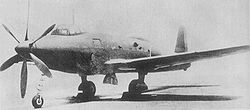Yokosuka R2Y
| Yokosuka R2Y "Keiun" | |
|---|---|

|
|
| Type: | Reconnaissance plane |
| Design country: | |
| Manufacturer: |
Yokosuka |
| First flight: |
May 1945 |
| Commissioning: |
was never put into service |
| Number of pieces: |
1 prototype |
The Yokosuka R2Y "Keiun" ( Japanese 景雲 - beautiful cloud) was a reconnaissance aircraft from the time of the Second World War , which did not get beyond the prototype stage.
history
At the beginning of World War II, the Imperial Japanese Navy recognized the need for a high-speed, long-range reconnaissance aircraft. Yokosuka then began developing the Yokosuka R1Y 1 Seiun (Japanese for blue cloud, factory name Y-30). The machine was to be powered by a 24-cylinder Mitsubishi engine with 2500 hp, but its development was so delayed that Yokosuka planned to use two Mitsubishi radial engines MK10A (Ha-42) instead. Since the performance of the engine did not meet expectations, the development of the R1Y was abandoned.
One then turned to the R2Y (factory designation Y-40), with the first studies being carried out in 1943. An Aichi Ha-70 -10 engine was planned in the middle of the fuselage , which propelled a six-blade propeller via a long-distance shaft. The Ha-70-10 essentially consisted of two Atsuta-30 engines arranged next to each other with a total take-off power of 2535 kW (3400 PS), which were a Japanese modification of the DB 601 . This should enable the R2Y to reach a top speed of around 720 km / h at an altitude of 10,000 m. In terms of its design, the R2Y was heavily influenced by the Heinkel He 119 , which had received export approval after the development work was stopped. Japan then acquired the two models V7 and V8 in addition to the reproduction rights. The machines were transported to Japan in boxes, reassembled there in the test center of the Japanese Navy Air Force and flown in by Captain Nitschke. A replica was not made, but the influence can be clearly seen in the design with the mid-engine and long-distance shaft. The sample of a six-blade propeller from VDM, which had also been delivered to Japan, was also used on the R2Y1.
When Japan lost the Battle of the Mariana Islands in 1944 , the specifications for the R2Y also changed, since the development of a long-range reconnaissance was no longer seen as a priority. Yokosuka should stop all work on the project. The company then proposed to develop a jet-powered version of the R2Y1 as a fast, light bomber called the R2Y2 Keiun-Kai. The piston engine-powered R2Y1 was also further developed by declaring it as an aerodynamic test vehicle for the jet variant.
Thus the prototype of the R2Y1 could be completed and transferred to the Yokosuka naval base on April 27, 1945 for taxi tests. After the detection of extreme nose wheel flutter, the transfer to the naval base Kisarazu followed, where the taxi attempts were resumed. Overheating problems of the engine were found here, but a short straight flight was possible on May 22nd (according to other sources on May 7th). The next day there was a full first flight. During the climb, a fire broke out in the engine area, which forced the pilot Kitajima to end the flight quickly. However, the damage done was minimal and attempts were made to use larger air inlets to remedy the problem, but this did not fully succeed. During engine test runs on the ground, the engine was irreparably damaged in mid-June; a replacement could not be delivered until July 1945, after which the prototype was completely destroyed by a direct hit in an American bomb attack.
At that time, a second R2Y1 was nearing completion and work on the R2Y2 had started. For the latter variant, two Mitsubishi Ne-330 jet engines (each with 12.95 kN thrust) were provided under the wings. The fuselage space freed by the failure of the engine was intended to be used for a fuel tank. Heavy automatic cannons and a bomb load of 1000 kg were planned for the armament.
Technical specifications
| Parameter | Data (R2Y1 "Keiun") |
|---|---|
| crew | 2 |
| length | 13.05 m |
| span | 14.00 m |
| height | 4.24 m |
| Wing area | 34.0 m² |
| Empty mass | 6,015 kg |
| Takeoff mass | normal 8,100 kg maximum 9,400 kg |
| Engine | a liquid-cooled twin- V 24-cylinder engine Aichi Ha-70 ; 2,536 kW (3,448 PS) kW (3400 PS) |
| calculated services | |
| Top speed | 770 km / h; 720 km / h at an altitude of 10,000 m |
| Marching speed | 463 km / h at an altitude of 4,000 m |
| Range | 3,610 km |
| Service ceiling | 11,700 m |
| Rate of climb | 476 m / min |
| Wing loading | 238 kg / m² |
| Power load | 0.31 kg / kW |
Web links
Individual evidence
- ↑ Yokosuka R2Y Keiun. WWII Imperial Japanese Naval Aviation Page, accessed December 10, 2009 .
- ^ Heinkel Project 1055 - Heinkel He 119. (Aviation Report, Issue 1). Verlag Heinz Nickel, 1993, ZDB -ID 2619386-3 , p. 24 ff.
- ↑ David Donald: Yokosuka R2Y1 Keiun - Japan's mid-engined twin. In: Wings of Fame, Volume 12, Aerospace Publishing, 1998, p. 35